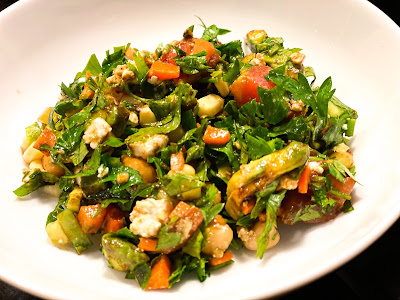
A good friend had a problem: his wife's birthday was a week away

and he had to organize a dinner for 25. Clay likes hosting Lesli's birthday party but doesn't enjoy the pressure of putting together the meal. In the past he had side-stepped the stress by ordering out.
For many years, the dinner party was catered by
Versailles a popular Cuban restaurant. This year he decided a pot luck dinner would make the meal more personal. Truth is Clay's talents lie in painting and photography and while he enjoys eating, he's happy to leave the cooking to others. But he had committed to preparing the main course and a side dish and even that felt burdensome. We discussed all this at our weekly Sunday brunch. I figured it was the manly thing to do to help him plan, shop, and prepare the dinner.
The central question was obvious: what to make for the main course that would feed 25 and wouldn't requir

e a huge amount of time in the kitchen? In the winter, the obvious answer would be a roast or a comfort dish like chicken and dumplings. Since Lesli's birthday falls in

the middle of summer when the air is warm and eating outdoors is the order of the day, something lighter was required.
Given that Lesli and my wife, Michelle, prefer simply prepared meals, we settled on easy-to-make grilled chicken breasts and Italian sweet sausages. For a side dish we talked about sautéed spinach, green beans with garlic and mushrooms, or grilled artichokes, any of which would go well with the grilled meats. In deference to eating locally, we made a plan to shop at the farmers' market the day of the party and decide what to make while we were at the market.


Saturday morning we met early at the Santa Monica farmers' market. Walking past the farmers' stalls we saw vegetables we hadn't thought about: summer squash and Japanese eggplants for grilling, plump carrots for a Moroccan flavored salad, and baby bok choy that we could stir fry with ginger, garlic and soy sauce.
Finally we settled on the obvious summer choice: a salad of
heirloom tomatoes in a simple vinaigrette.

Right now the profusion of

tomatoes in the market is nothing short of phenomenal: Brandywines (red, yellow, black), Cherokee Purples, Green Zebras, even a sweet cherry tomato called Snow White.
We also saw fresh Italian parsley, shallots, ginger, and garlic. Those flavors could bring a helpful lift to the chicken breasts. We decided on a simple butter sauce and a crispy topping of bacon, shallots, garlic, ginger, and Italian parsley leaves.
The nice part about pot luck meals is you discover things you didn't know about your friends.

Talking with Melissa about what she was going to bring, I learned that she and her husband had just gotten back from a trip to
Napa. She happily applied her recent experience and brought a terrific platter of cheeses (each one with its own flag-label) accompanied by a fig spread, grapes, strawberries, and nuts.
Heirloom Tomato SaladYield: 4 servings
Time: 10 minutes
Ingredients
2 pounds ripe heirloom tomatoes (washed, stems removed)
1/2 basket ripe heirloom cherry tomatoes (washed, stems removed, halved)
1 ripe avocado (washed, peeled, pit removed, roughly chopped)
1/2 cup olives (cracked green or black, pitted, roughly chopped)
3 tablespoons olive oil
1/4 cup balsamic vinegar
Sea salt and pepper
MethodOn a very low flame heat the vinegar in a small saucepan until reduced to 1 tablespoon.
Cut the large tomatoes into quarters or chunks or slices--whatever you prefer--gently toss them with the cherry tomatoes, avocado, olives, olive oil and reduced balsamic vinegar. Season to taste with sea salt and pepper.
VariationsAdd cilantro or Italian parsley leaves, roughly chopped.
Add red onion or scallions, peeled, finely chopped.
Chicken Breasts with Butter Sauce and a Crispy ToppingYield: 4 servings
 Time:
Time: 1 hour
Ingredients
4 boneless, skinless chicken breast halves (washed, pat dried)
4 slices bacon (finely chopped)
4 shallots (peeled, finely julienned)
2" piece of fresh ginger (peeled, finely julienned)
4 garlic cloves (peeled, finely julienned)
1/2 cup Italian parsley (washed, dried, leaves only)
1/4 cup sweet butter
1/2 cup chicken stock
Olive oil
Sea salt and pepper
6 cups safflower oil
MethodMake the crispy part first. Heat the oil in a deep pan like a wok so that when the ingredients are

added and the oil foams up, the pan is deep enough that the oil won't flow onto the stove. You can tell this was a lesson I learned the hard way. Test the oil by dropping in a parsley leaf. If it crisps in 5-6 seconds, the oil's hot enough. Cook the bacon, ginger, garlic, parsley, and shallots separately. Have a slotted spoon or a fine-mesh strainer ready because they will cook in a few seconds. Remove each and let drain on a paper towel.
Drizzle olive oil onto a plate, then season with sea salt and pepper. Dredge each chicken breast half through the seasoned oil. Either grill the breasts on a barbecue or sauté in a medium-hot pan until browned on each side. Put the breasts on a plate and cover lightly with a piece of aluminum foil. Heat butter and chicken stock in a sauté pan and reduce until thickened.
Arrange the breasts on a platter, drizzle with the butter sauce, and top with the crispy bits.










































